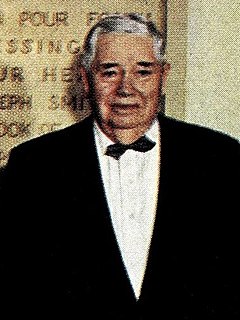Wilford McGavin McKendrick (June 12, 1870 – May 11, 1936) served as principal of Weber Stake Academy, the predecessor of Weber State University from 1908 to 1910.

Weber State University is a public university in the western United States, located in Ogden, Utah, north of Salt Lake City. It is a coeducational, publicly supported university offering professional, liberal arts and technical certificates, as well as associate's, bachelor's, and master's degrees. Weber State University is accredited by the Northwest Commission on Colleges and Universities. Programs throughout the university are accredited as well. The city of Ogden is the seat of Weber County.
McKendrick was raised in Tooelle, Utah. He had received both high school and college education at Brigham Young Academy and had been a member of that school's faculty. Among other positions McKendrick served as the librarian at Brigham Young Academy. McKendrick had been a faculty member at Weber Academy before he became the principal, filling the vacancy left by David O. McKay when he resigned to serve as a member of the Quorum of the Twelve Apostles of The Church of Jesus Christ of Latter-day Saints (LDS Church).

David Oman McKay was an American religious leader and educator who served as the ninth president of The Church of Jesus Christ of Latter-day Saints from 1951 until his death in 1970. Ordained an apostle and member of the Quorum of the Twelve Apostles in 1906, McKay was a general authority for nearly 64 years, longer than anyone else in LDS Church history, except Eldred G. Smith.

In The Church of Jesus Christ of Latter-day Saints, the Quorum of the Twelve Apostles is one of the governing bodies in the church hierarchy. Members of the Quorum of the Twelve Apostles are apostles, with the calling to be prophets, seers, and revelators, evangelical ambassadors, and special witnesses of Jesus Christ.

The Church of Jesus Christ of Latter-day Saints, often informally known as the LDS Church or Mormon Church, is a nontrinitarian, Christian restorationist church that is considered by its members to be the restoration of the original church founded by Jesus Christ. The church is headquartered in Salt Lake City, Utah in the United States, and has established congregations and built temples worldwide. According to the church, it has over 16 million members and 67,000 full-time volunteer missionaries. In 2012, the National Council of Churches ranked the church as the fourth-largest Christian denomination in the United States, with over 6.5 million members reported by the church, as of January 2018. It is the largest denomination in the Latter Day Saint movement founded by Joseph Smith during the period of religious revival known as the Second Great Awakening.
McKendrick was a Latter-day Saint. In the LDS Church he was a counselor in the Ogden Stake presidency.
A stake is an administrative unit composed of multiple congregations in certain denominations of the Latter Day Saint movement. The name "stake" derives from the Book of Isaiah: "enlarge the place of thy tent; stretch forth the curtains of thine habitation; spare not, lengthen thy cords, and strengthen thy stakes". A stake is sometimes referred to as a stake of Zion.









